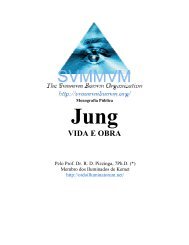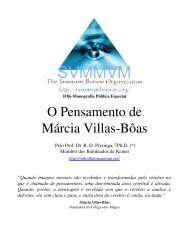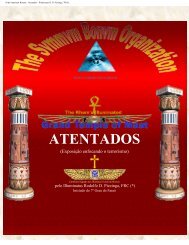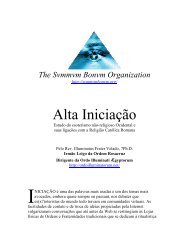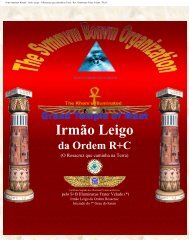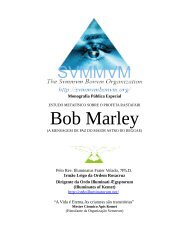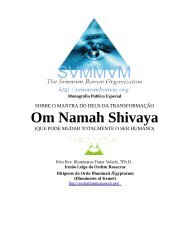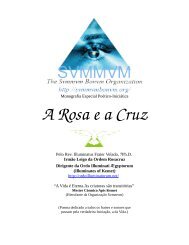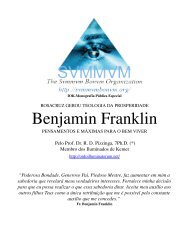History Of The Rose-Croix Sedir - Ordo Svmmvm Bonvm
History Of The Rose-Croix Sedir - Ordo Svmmvm Bonvm
History Of The Rose-Croix Sedir - Ordo Svmmvm Bonvm
You also want an ePaper? Increase the reach of your titles
YUMPU automatically turns print PDFs into web optimized ePapers that Google loves.
Amphitheatrum sapientiae aeternae (13) where Khunrath, into 1598, drew a Christ, the<br />
arms in cross, in a pink of light and a figure of the Pronostication of Paracelse (1536) on the<br />
other hand, to affirm that " the Rosicrucian brotherhood, whose emblèmesconstitutifs defer<br />
us to the poems of Dante and Guillaume de Lorris, functioned very a long time in the shade<br />
before appearing by works of full day " (7). Let us say only that on an external similarity<br />
one can base neither an identity nor a chronology. In any case, the only thing that we know<br />
of unquestionable certainty, it is that the manifestation of the Rosicrucian brotherhood was<br />
public only during the appearance of Fama, i.e. in 1614. It is necessary to mention here a<br />
declaration of Henri Neuhaus. This doctor of Dantzig published into 1618 an often translated<br />
opuscule (14) where it affirms the existence of the Company of the Rosicrucian<br />
brotherhood and the goal which it wants to reach. He declares there that at the time of the<br />
Thirty year old war the Rosicrucian brotherhood left Europe and withdrew themselves in<br />
India. No writer rosicrucian gives this information. Nearly one century later, Sincerus Renatus<br />
reproduces it. Let us stress that the booklet of Neuhaus is written on a tone airspeed<br />
indicator; its French translation was often joined together with makes out of Gabriel Naudé<br />
about which we will speak further. <strong>The</strong> writers rosicrucians sought several times to refute<br />
these two authors (15). And the P. Jacques Gaultier, of the Company of Jesus, the large<br />
adversary of Fraternity, said book of Neuhaus " whom one did not know if it were for or<br />
counters the Rosicrucian brotherhood ". (1) E AROUX: <strong>The</strong> Comedy of Dante, to translate<br />
into worms according to the letter and with accompanying notes according to the spirit;<br />
followed key of the language symbolic of Faithful of Love. Paris (Renouard), 1856, 2 flight.<br />
Aroux is also the author of a book entitled: Heretic, revolutionary and socialist Dante. (2) It is<br />
to be noticed that Dante takes as guides in the highest circles of the holy Paradise Bernard,<br />
which wrote the rule of the Command of the Temple. (3) the author adds in note: " It acted,<br />
in the Third Command, to constitute an immense army which had in heart to make reign<br />
more justice and of equality among the men ". Frederic MORIN: Saint.françois.d'.assise and<br />
Franciscains. Paris, 1853. (4) Esotericism of Dante. Paris (CH Bump), 1925. (5) " I request<br />
so that all are like you, Père, you are in me and me of you ". (Gospel of saint Jean XVII, 21.<br />
" <strong>The</strong>y are three which return testimony in the sky: the Father, the Verb and the Holy Spirit<br />
and these three are one; and they are three which return testimony on the ground: the Spirit,<br />
water and blood and these three are one " (1st Epitre of saint Jean V, 8). (6) Jean ARNDT,<br />
one of the principal writers rosicrucians, translated into German the Imitation of Jesus-Christ.<br />
7) Résumé of all the philosophy and the alchemy of the Fraternity of the Rosicrucian<br />
brotherhood, made by command of the sérénissime count de Falkenstein, our Imperator; in<br />
the year of Lord 1574.<br />
CHAPTER IV SYMBOLISM OF THE ROSICRUCIAN RULES OF THE COMMAND<br />
One proposed several assumptions to explain the title of Rosicrucian brotherhood.<br />
According to the first, this name would come from the legendary founder of Fraternity,<br />
Christian <strong>Rose</strong>ncreutz. We will examine it hereafter. <strong>The</strong> second assumption makes come<br />
the word from Latin Ros, dew and Crux, cross. It is due to Mosheim, as teaches it to us<br />
Waite (1), and one finds it in the Encyclopaedia of Ree and in other publications " Among all<br />
the bodies of nature, the dew was that which had the greatest capacity dissolving on gold;<br />
the cross, in alchemical language, represented the light, Lux, because all the letters of this<br />
word can be found in the figure of a cross. However the light is called the seed or the<br />
menstrue red dragon, coarse and material light which, digested and transformed, produces<br />
gold. If all this is admitted, a philosopher rosicrucian will be that which seeks, by the means<br />
of the dew, the light or philosopher's stone " (16) We will not stop with this second<br />
explanation. We already underlined the secondary character that the Rosicrucian<br />
brotherhood allotted to alchemy. <strong>The</strong>y would not have chosen an alchemical image to make<br />
the symbol of their Fraternity of it. <strong>The</strong> third assumption explains this denomination by the<br />
pink and the cross. It is it which conquered the most partisans and who provides the<br />
greatest quota of symbolic systems explanations. " the pink, known as Eliphas Lévi, in a




